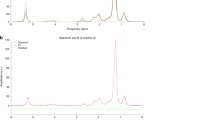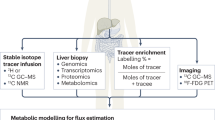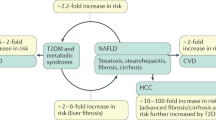Abstract
Hepatic steatosis is defined by an increased content of hepatocellular lipids (HCLs) and is frequently observed in insulin-resistant states including type 2 diabetes mellitus. A dietary excess of saturated fat contributes significantly to HCL accumulation. Elevated HCL levels mainly account for hepatic insulin resistance, which is probably mediated by partitioning of free fatty acids to the liver (fat overflow) and by an imbalance of adipocytokines (decreased adiponectin and/or increased proinflammatory cytokines). Both free fatty acids and adipocytokines activate inflammatory pathways that include protein kinase C, the transcription factor nuclear factor κB, and c-Jun N-terminal kinase 1 and can thereby accelerate the progression of hepatic steatosis to nonalcoholic steatohepatitis and cirrhosis. Proton magnetic resonance spectroscopy has made it possible to quantify HCL concentrations and to detect even small changes in these concentrations in clinical settings. Moderately hypocaloric, fat-reduced diets can decrease HCL levels by ∼40–80% in parallel with loss of up to 8% of body weight. Treatment with thiazolidinediones (e.g. pioglitazone and rosiglitazone) reduces HCL levels by 30–50% by modulating insulin sensitivity and endocrine function of adipose tissue in type 2 diabetes. Metformin improves hepatic insulin action without affecting HCL levels, whereas insulin infusion for 67 h increases HCL levels by ∼18%; furthermore, HCL levels positively correlate with the insulin dosage in insulin-treated type 2 diabetes. In conclusion, liver fat is a critical determinant of metabolic fluxes and inflammatory processes, thereby representing an important therapeutic target in insulin resistance and type 2 diabetes mellitus.
Key Points
-
Hepatic steatosis is diagnosed when more than 5% of the content of liver cells is lipid and is typical in insulin-resistant states, including type 2 diabetes mellitus
-
Free fatty acids (fat overflow) and imbalance of adipocytokines contribute to elevated hepatocellular lipid (HCL) levels and hepatic insulin resistance
-
Mitochondrial dysfunction and activation of inflammatory pathways seem to be the major intracellular mechanisms determining hepatic steatosis and its progression to nonalcoholic steatohepatitis
-
Proton magnetic resonance spectroscopy allows quantification of HCL concentrations in clinical settings
-
Fat-reduced diets and thiazolidinediones decrease HCL levels by ∼30–80%, whereas insulin infusion increases HCL levels by ∼18%
-
Liver fat is a novel therapeutic target in insulin resistance and type 2 diabetes mellitus
This is a preview of subscription content, access via your institution
Access options
Subscribe to this journal
Receive 12 print issues and online access
$209.00 per year
only $17.42 per issue
Buy this article
- Purchase on SpringerLink
- Instant access to full article PDF
Prices may be subject to local taxes which are calculated during checkout





Similar content being viewed by others
References
DeFronzo RA (2004) Pathogenesis of type 2 diabetes. Med Clin North Am 88: 787–835
Choudhury J and Sanyal AJ (2004) Clinical aspects of fatty liver disease. Semin Liver Dis 24: 349–362
Roden M and Bernroider E (2003) Hepatic glucose metabolism—its role in health and disease. Best Pract Res Clin Endocrinol Metab 17: 365–383
Krssak M et al. (2004) Postprandial hepatic glycogen metabolism in type 2 diabetes. Diabetes 53: 3048–3056
Krssak M and Roden M (2004) The role of lipid accumulation in liver and muscle for insulin resistance and type 2 diabetes mellitus in humans. Rev Endocr Metab Disord 5: 127–134
Nielsen S et al. (2004) Splanchnic lipolysis in human obesity. J Clin Invest 113: 1582–1588
Donnelly KL et al. (2005) Sources of fatty acids stored in liver and secreted via lipoproteins in patients with nonalcoholic fatty liver disease. J Clin Invest 115: 1343–1351
Ravikumar B et al. (2005) Real-time assessment of postprandial fat storage in liver and skeletal muscle in health and type 2 diabetes. Am J Physiol Endocrinol Metab 288: E789–E797
Heath RB et al. (2003) Selective partitioning of dietary fatty acids into the VLDL TG pool in the early postprandial period. J Lipid Res 44: 2065–2072
Tamura S and Shimomura I (2005) Contribution of adipose tissue and de novo lipogenesis to nonalcoholic fatty liver disease. J Clin Invest 115: 1139–1142
Brea A et al. (2005) Nonalcoholic fatty liver disease is associated with carotid atherosclerosis. A case–control study. Arterioscler Thromb Vasc Biol 25: 1–6
Unger RH (2003) Lipid overload and overflow: metabolic trauma and the metabolic syndrome. Trends Endocrinol Metab 14: 398–403
Lowell BB and Shulman GI (2005) Mitochondrial dysfunction and type 2 diabetes. Science 307: 384–387
Lazar MA (2005) How obesity causes diabetes: not a tall tale. Science 307: 373–375
Kadowaki T and Yamauchi T (2005) Adiponectin and adiponectin receptors. Endocr Rev 26: 439–451
McGarry JD (2002) Banting lecture 2001: dysregulation of fatty acid metabolism in the etiology of type 2 diabetes. Diabetes 51: 7–18
Gavrilova O et al. (2000) Surgical implantation of adipose tissue reverses diabetes in lipoatrophic mice. J Clin Invest 105: 271–278
Petersen KF et al. (2002) Leptin reverses insulin resistance and hepatic steatosis in patients with severe lipodystrophy. J Clin Invest 109: 1345–1350
Simha V et al. (2003) Effect of leptin replacement on intrahepatic and intramyocellular lipid content in patients with generalized lipodystrophy. Diabetes Care 26: 30–35
Krebs M et al. (2001) Free fatty acids inhibit glucose-stimulated increases of intramuscular glucose-6-phosphate concentrations in man. J Clin Endocrinol Metab 86: 2153–2160
Lam TK et al. (2002) Free fatty acid-induced hepatic insulin resistance: a potential role for protein kinase C-δ. Am J Physiol Endocrinol Metab 283: E682–E691
Samuel VT et al. (2004) Mechanism of hepatic insulin resistance in non-alcoholic fatty liver disease. J Biol Chem 279: 32345–32353
Wellen KE and Hotamisligil GS (2005) Inflammation, stress, and diabetes. J Clin Invest 115: 1111–1119
Roden M et al. (2000) Relative hypoleptinemia in type 1 and type 2 diabetes mellitus. Int J Obesity 24: 976–981
Brabant G et al. (2005) Hepatic leptin signalling in obesity. FASEB J 19: 1048–1050
Ikejima K et al. (2002) Leptin receptor-mediated signaling regulates hepatic fibrogenesis and remodeling of extracellular matrix in the rat. Gastroenterology 122: 1399–1410
Angulo P et al. (2004) Leptin, insulin resistance, and liver fibrosis in human nonalcoholic fatty liver disease. J Hepatol 41: 943–949
Ofei F et al. (1996) Effects of an engineered human anti-TNF-α antibody (CDP571) on insulin sensitivity and glycemic control in patients with NIDDM. Diabetes 45: 881–885
Paquot N et al. (2000) No increased insulin sensitivity after a single intravenous administration of a recombinant human tumor necrosis factor receptor: Fc fusion protein in obese insulin-resistant patients. J Clin Endocrinol Metab 85: 1316–1319
Arner P (2005) Resistin: yet another adipokine tells us that men are not mice. Diabetologia 48: 2203–2205
Chen MP et al. (2006) Elevated plasma level of visfatin/pre-B cell colony-enhancing factor in patients with type 2 diabetes mellitus. J Clin Endocrinol Metab 91: 295–299
Brehm A et al. (2006) Increased lipid availability impairs insulin stimulated ATP synthesis in human skeletal muscle. Diabetes 55: 136–140
Perez-Carreras M et al. (2003) Defective hepatic mitochondrial respiratory chain in patients with non-alcoholic steatohepatitis. Hepatology 38: 999–1007
Cai D et al. (2005) Local and systemic insulin resistance resulting from hepatic activation of IKK-β and NFκ B. Nat Med 11: 183–190
Targher et al. (2005) Nonalcoholic fatty liver diseases and risk of future cardiovascular events among type 2 diabetic patients. Diabetes 54: 3541–3546
Adams LA and Angulo P (2005) Recent concepts in non-alcoholic fatty liver disease. Diabet Med 22: 1129–1133
Adams LA et al. (2005) The histological course of nonalcoholic fatty liver disease: a longitudinal study of 103 patients with sequential liver biopsies. J Hepatol 42: 132–138
Wanless IR and Lentz JS (1990) Fatty liver hepatitis (steatohepatitis) and obesity: an autopsy study with analysis of risk factors. Hepatology 12: 1106–1110
Angulo P et al. (1999) Independent predictors of liver fibrosis in patients with non-alcoholic steatohepatitis. Hepatology 30: 1356–1362
Adams et al. (2005) The natural history of nonalcoholic fatty liver disease: a population-based cohort study. Gastroenterology 129: 113–121
Hui JM et al. (2004) Beyond insulin resistance in NASH: TNF-α or adiponectin? Hepatology 40: 46–54
Bugianesi E et al. (2005) Plasma adiponectin in nonalcoholic fatty liver is related to hepatic insulin resistance and hepatic fat content, not to liver disease severity. J Clin Endocrinol Metab 90: 3498–3504
Expert panel on detection, evaluation, and treatment of high blood cholesterol in adults (2001) Executive summary of the third report of the national cholesterol education program (NCEP) expert panel on detection, evaluation, and treatment of high blood cholesterol in adults (adult treatment panel III). JAMA 285: 2486–2497
Marchesini G et al. (2001) Nonalcoholic fatty liver disease: a feature of the metabolic syndrome. Diabetes 50: 1844–1850
Bugianesi E et al. (2005) Insulin resistance in non-diabetic patients with non-alcoholic fatty liver disease: sites and mechanisms. Diabetologia 48: 634–642
Vozarova B et al. (2002) High alanine aminotransferase is associated with decreased hepatic insulin sensitivity and predicts the development of type 2 diabetes. Diabetes 51: 1889–1895
Sattar N et al. (2004) Elevated alanine aminotransferase predicts new-onset type 2 diabetes independently of classical risk factors, metabolic syndrome, and C-reactive protein in the west of Scotland coronary prevention study. Diabetes 53: 2855–2860
Jimba S et al. (2005) Prevalence of non-alcoholic fatty liver disease and its association with impaired glucose metabolism in Japanese adults. Diabet Med 22: 1141–1145
Joy D et al. (2003) Diagnosis of fatty liver disease: is biopsy necessary? Eur J Gastroenterol Hepatol 15: 539–543
Browning JD et al. (2004) Prevalence of hepatic steatosis in an urban population in the United States: impact of ethnicity. Hepatology 40: 1387–1395
Sargin M et al. (2003) Association of nonalcoholic fatty liver disease with insulin resistance: is OGTT indicated in nonalcoholic fatty liver disease? J Clin Gastroenterol 37: 399–402
Anderwald C et al. (2002) Effects of insulin treatment in type 2 diabetic patients on intracellular lipid content in liver and skeletal muscle. Diabetes 51: 3025–3032
Mayerson AB et al. (2002) The effects of rosiglitazone on insulin sensitivity, lipolysis, and hepatic and skeletal muscle triglyceride content in patients with type 2 diabetes. Diabetes 51: 797–802
Ryysy L et al. (2000) Hepatic fat content and insulin action on free fatty acids and glucose metabolism rather than insulin absorption are associated with insulin requirements during insulin therapy in type 2 diabetic patients. Diabetes 49: 749–758
Kelley DE et al. (2003) Fatty liver in type 2 diabetes mellitus: relation to regional adiposity, fatty acids, and insulin resistance. Am J Physiol Endocrinol Metab 285: E906–E916
Tiikkainen M et al. (2002) Liver-fat accumulation and insulin resistance in obese women with previous gestational diabetes. Obes Res 10: 859–867
Seppala-Lindroos A et al. (2002) Fat accumulation in the liver is associated with defects in insulin suppression of glucose production and serum free fatty acids independent of obesity in normal men. J Clin Endocrinol Metab 87: 3023–3028
Sutinen J et al. (2002) Increased fat accumulation in the liver in HIV-infected patients with antiretroviral therapy-associated lipodystrophy. AIDS 16: 2183–2193
Westerbacka J et al. (2005) Dietary fat content modifies liver fat in overweight nondiabetic subjects. J Clin Endocrinol Metab 90: 2804–2809
Tiikkainen M et al. (2003) Effects of identical weight loss on body composition and features of insulin resistance in obese women with high and low liver fat content. Diabetes 52: 701–707
Petersen KF et al. (2005) Reversal of nonalcoholic hepatic steatosis, hepatic insulin resistance, and hyperglycemia by moderate weight reduction in patients with type 2 diabetes. Diabetes 54: 603–608
Tamura Y et al. (2005) Effects of diet and exercise on muscle and liver intracellular lipid contents and insulin sensitivity in type 2 diabetic patients. J Clin Endocrinol Metab 90: 3191–3196
Carey DG et al. (2002) Effect of rosiglitazone on insulin sensitivity and body composition in type 2 diabetic patients. Obes Res 10: 1008–1015
Bajaj M et al. (2003) Pioglitazone reduces hepatic fat content and augments splanchnic glucose uptake in patients with type 2 diabetes. Diabetes 52: 1364–1370
Bajaj M et al. (2004) Decreased plasma adiponectin concentrations are closely related to hepatic fat content and hepatic insulin resistance in pioglitazone-treated type 2 diabetic patients. J Clin Endocrinol Metab 89: 200–206
Bajaj M et al. (2004) Plasma resistin concentration, hepatic fat content, and hepatic and peripheral insulin resistance in pioglitazone-treated type II diabetic patients. Int J Obes 28: 783–789
Roden M et al. (2001) Nuclear magnetic resonance studies of hepatic glucose metabolism in humans. Recent Prog Horm Res 56: 219–237
Nair S et al. (2004) Metformin in the treatment of non-alcoholic steatohepatitis: a pilot open label trial. Aliment Pharmacol Ther 20: 23–28
Tiikkainen M et al. (2004) Effects of rosiglitazone and metformin on liver fat content, hepatic insulin resistance, insulin clearance, and gene expression in adipose tissue in patients with type 2 diabetes. Diabetes 53: 2169–2176
Brehm A et al. (2005) Comparison of the effects of glimepiride vs. pioglitazone + nateglinide therapy on insulin sensitivity and ectopic fat storage in well-controlled type 2 diabetes [abstract]. Diabetes 54 (Suppl 1): A381
Müller G (2000) The molecular mechanism of the insulinmimetic/sensitizing activity of the antidiabetic sulfonylurea drug amaryl. Mol Med 6: 907–933
Katoh S et al. (2001) Troglitazone prevents the rise in visceral adiposity and improves fatty liver associated with sulfonylurea therapy—a randomized controlled trial. Metabolism 50: 414–417
Acknowledgements
The author's studies are supported by the Austrian Science Fund (FWF) most recent grant P15656, Austrian National Bank (ÖNB), European Foundation for the Study of Diabetes (EFSD), and the Herzfelder Family Trust. The continuous cooperation of the Department of Internal Medicine III and the Centre of Excellence for High Field NMR, Medical University of Vienna, Austria, is gratefully acknowledged. Special thanks are owed to the voluntary participants of our studies and to my numerous co-workers and collaborators over the years.
Author information
Authors and Affiliations
Corresponding author
Ethics declarations
Competing interests
Michael Roden has been consultant for Sanofi Aventis and received honoraria for lectures and advisory boards from GlaxoSmithKline, Merck, Menarini, Novo Nordisk, Pfizer, sanofi Aventis, Servier and Takeda.
Rights and permissions
About this article
Cite this article
Roden, M. Mechanisms of Disease: hepatic steatosis in type 2 diabetes—pathogenesis and clinical relevance. Nat Rev Endocrinol 2, 335–348 (2006). https://doi.org/10.1038/ncpendmet0190
Received:
Accepted:
Issue Date:
DOI: https://doi.org/10.1038/ncpendmet0190



